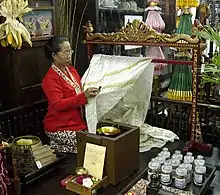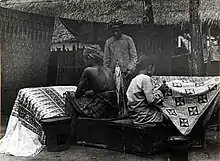Canting
Tjanting (IPA: t͡ʃɑnʈɪŋ, VOS Spelling: tjanting, Javanese: ꦕꦤ꧀ꦛꦶꦁ, romanized: Tjanting) is a pen-like tool used to apply liquid hot wax (Javanese: malam) in the batik-making process in Indonesia, more precisely batik tulis (lit. "written batik"). Traditional Tjanting consists of copper wax-container with small pipe spout and bamboo handle. Traditional tjanting is made of copper, bronze, zinc or iron material, however modern version might use teflon.
 Tjanting used in the batik-making process | |
| Types | Rengreng, Isen, Cecek, Klowong, Tembokan, Cecekan, Loron, Telon, Prapatan, Liman, Byok, Galaran |
|---|---|
| Used with | Wax, Batik |
| Inventor | Javanese[1][2][3][4][5] |
| Manufacturer | Indonesian (Javanese) |
| Related |  The batik making tools displayed at National Museum of Indonesia, Jakarta. From center top: tjanting a fine tool to apply wax; from left to right: wooden brush with coconut fibre hair, Iron calipers for measuring, also calipers, tongs, hammer, and file. |
Etymology
.jpg.webp)
Canting is derived from Javanese word of canthing ꦕꦤ꧀ꦛꦶꦁ (IPA: t͡ʃɑnʈɪŋ) which means the small scooping tool.[6][7]
History
Canting is originated in Java and invented by the Javanese,[8][9][10][11] it is believed to be invented since c. 12th century.[12] G. P. Rouffaer reported that the gringsing batik pattern was already known by the 12th century in Kediri, East Java. He concluded that this delicate pattern could only be created by the canting, an etching tool that holds a small reservoir of hot wax.[13]

Design
.jpg.webp)
A canting consists of:
- Nyamplung: a rounded liquid wax container, made from copper.
- Cucuk (IPA:tʃutʃuk): a small copper pipe or spout that connects to nyamplung container, it is where the liquid wax comes out to be applied to the cloth.
- Gagang: canting holder, usually made from bamboo or wood.
The size of canting may be varied according to the desired dot size or line thickness to be applied to the cloth. A batik craftsperson uses canting in a similar fashion as drawing using a pen.
Types
.jpg.webp)

There are three ways of classifying the types of canting:
- Based on its function:
- Canting Rengrengan: canting that is ideally used to make a batik pattern for the first time.
- Canting Isen: canting that is ideally used to fill a pattern that has been made beforehand.
- Based on the diameter of its cucuk:
- Small Canting: canting that has a small-sized cucuk with a diameter of less than 1 millimeter and is usually used as Canting Isen.
- Medium Canting: canting that has a medium-sized cucuk with a diameter of 1 – 2.5 millimeters and is usually used as Canting Rengrengan.
- Large Canting: canting with a large-sized cucuk with a diameter of more than 2.5 millimeters and is usually used to make a larger batik pattern or to fill a pattern that has been made beforehand with a block of wax.
- Based on the number of its cucuk:
- Canting Cecekan: canting with one cucuk.
- Canting Laron/Loron: canting with two cucuk.
- Canting Telon: canting with three cucuk[14] that forms an equilateral triangle.
- Canting Prapatan: canting with four cucuk that forms a square.
- Canting Liman: canting with five cucuk that forms a square with a dot in the center of the square.
- Canting Byok: canting with an odd number of cucuk and is equal to or more than seven cucuk that forms a circle with a dot in the center of the circle.
- Canting Renteng/Galaran: canting with four or six cucuk that forms two parallel lines.[15]

Technique
Firstly, the cloth must be washed, soaked and beaten with a large mallet. The hot and liquid wax is scooped from small wajan (wok) heated upon small stove. The batik craftsperson sometimes blow the spout tip of canting to allow the liquid wax to flow smoothly and to avoid clogging, then they draw the line or dot upon the cloth, applying the liquid wax, following the patterns and images that previously had been drawn using pencil.[16] A pattern is then drawn with hot wax called malam using canting. The wax functions as a dye-resist. After this, the cloth is dipped in a dye bath containing the first colour. After the cloth is dry, the wax is removed by scraping or boiling the cloth. This process is repeated as many times as the number of colours desired. For larger areas of cloth which need to be covered, the wax is applied using a tool called tonyok nemboki/mopoki.[17]
References
- Tirta, Iwan; Steen, Gareth L.; Urso, Deborah M.; Alisjahbana, Mario (1996). Batik: A Play of Lights and Shades. Vol. 1. Gaya Favorit Press. ISBN 978-979-515-313-9.
- Ratna, Roostika (2019). "TERRITORIAL MARKETING AND COLLECTIVE BRANDING TO SUPPORT REGIONAL DEVELOPMENT: A STUDY OF SMEs BATIK INDUSTRY". Russian Journal of Agricultural and Socio-Economic Sciences. 90 (6): 97–106. doi:10.18551/rjoas.2019-06.14. Retrieved 4 February 2021.
- Akhir, Noor Haslina Mohamad; Ismail, Normaz Wana; Said, Rusmawati; Ranjanee, Shivee; Kaliappan, P (2015). "Traditional Craftsmanship:The Origin, Culture, and Challenges of Batik Industry in Malaysia". Islamic Perspectives Relating to Business, Arts, Culture and Communication: 229–237. doi:10.1007/978-981-287-429-0_22. ISBN 978-981-287-428-3. Retrieved 4 February 2021.
- Lee, Thienny (2016). "Defining the Aesthetics of the Nyonyas' Batik Sarongs in the Straits Settlements, Late Nineteenth to Early Twentieth Century". Asian Studies Review. 40 (2): 173–191. doi:10.1080/10357823.2016.1162137. S2CID 147124182. Retrieved 4 February 2021.
- Baasanjargal, Tsolmonchimeg; Soon-Joo, Ahn; Mi-Jeong, Kwon (2019). "인도네시아 바틱전통 패턴의 비교 분석 : 자바섬의 족자카르타와 페칼롱간의 패턴을 중심으로 [Comparative Analysis of Indonesian Batik Traditional Patterns: Focused on Patterns of Yogyakarta and Pekalongan in Java Island]". 한복문화. 22 (3): 75–91. doi:10.16885/jktc.2019.09.22.3.75. S2CID 210612600. Retrieved 4 February 2021.
- Hariyanto, Isbandono (2015). "CANTING: SENI DAN TEKNOLOGI DALAM PROSES BATIK" [CANTING: ARTS AND TECHNOLOGY IN THE BATIK PROCESS]. ATRAT: Fine Arts Journal (in Indonesian). 3 (3). Retrieved 4 February 2021.
- "Using Javanese Cantings". textiletraders.co.uk. Textile Traders. Retrieved 4 February 2021.
- Ratna, Roostika (2019). "TERRITORIAL MARKETING AND COLLECTIVE BRANDING TO SUPPORT REGIONAL DEVELOPMENT: A STUDY OF SMEs BATIK INDUSTRY". Russian Journal of Agricultural and Socio-Economic Sciences. 90 (6): 97–106. doi:10.18551/rjoas.2019-06.14. Retrieved 4 February 2021.
- Akhir, Noor Haslina Mohamad; Ismail, Normaz Wana; Said, Rusmawati; Ranjanee, Shivee; Kaliappan, P (2015). "Traditional Craftsmanship:The Origin, Culture, and Challenges of Batik Industry in Malaysia". Islamic Perspectives Relating to Business, Arts, Culture and Communication: 229–237. doi:10.1007/978-981-287-429-0_22. ISBN 978-981-287-428-3. Retrieved 4 February 2021.
- Lee, Thienny (2016). "Defining the Aesthetics of the Nyonyas' Batik Sarongs in the Straits Settlements, Late Nineteenth to Early Twentieth Century". Asian Studies Review. 40 (2): 173–191. doi:10.1080/10357823.2016.1162137. S2CID 147124182. Retrieved 4 February 2021.
- Baasanjargal, Tsolmonchimeg; Soon-Joo, Ahn; Mi-Jeong, Kwon (2019). "인도네시아 바틱전통 패턴의 비교 분석 : 자바섬의 족자카르타와 페칼롱간의 패턴을 중심으로 [Comparative Analysis of Indonesian Batik Traditional Patterns: Focused on Patterns of Yogyakarta and Pekalongan in Java Island]". 한복문화. 22 (3): 75–91. doi:10.16885/jktc.2019.09.22.3.75. S2CID 210612600. Retrieved 4 February 2021.
- Tirta, Iwan; Steen, Gareth L.; Urso, Deborah M.; Alisjahbana, Mario (1996). Batik: A Play of Lights and Shades. Vol. 1. Gaya Favorit Press. ISBN 978-979-515-313-9.
- Tirta, Iwan; Steen, Gareth L.; Urso, Deborah M.; Alisjahbana, Mario (1996). Batik: A Play of Lights and Shades. Vol. 1. Gaya Favorit Press. ISBN 978-979-515-313-9.
- Margono, Tri Edy; Aziz, Abdul (2010). Mari Belajar Seni Rupa (PDF). Jakarta: Pusat Perbukuan Kementerian Pendidikan Nasional. p. 75. ISBN 978-979-095-004-7. Archived from the original (PDF) on 2017-10-26. Retrieved 2017-11-08.
- "Macam-Macam Canting untuk Membatik". Kesolo. January 2, 2015. Retrieved October 15, 2017.
- Tim Bina Karya Guru. 2007. "Seni Budaya dan Keterampilan Untuk Sekolah Dasar Kelas VI". Penerbit Erlangga. ISBN 978-979-015-060-7.
- Batik Nomination for inscription on the Representative List in 2009 (Reference No. 00170)



.jpg.webp)